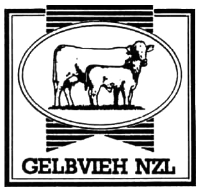Gelbvieh – “The Smart Cross” – Performance Carcass Maternal
Origin
Northern Bavaria, Germany
Colour
Reddish-gold to russet, or black. Dilutor gene is carried by some Gelbvieh.
Meat Type
Lean with a high % of retail yield.
Maturity
Medium to Late.
Birthweight
Purebred males average 40kg, female average 38kg.
Temperament
Very good.
Milk
One of the highest milk procers among beef breeds.
Pre-weaning growth
Exceptionally fast, comparable or better than Charolais.
Feed Conversion Efficiency
One of the most efficient of all breeds.
Calving
Generally good performers but some care advisable when selecting sires for cross breeding over maiden heifers from smaller breeds.
Description
Medium to large, long body with above average muscling Originally horned, the majority now polled.
Gelbvieh – the quiet maternal versatile European breed
Gelbvieh were developed in the three Franconian districts of the Northern Bavaria region of Germany in the early 19th century. The “red-yellow Franconian cattle” were developed from several local strains including the Celtic-German Landrace and Heil-Brown cattle. Thus, with stringent sire testing and planned mating programs, Gelbvieh were moulded into a superior dual purpose animal for beef and milk production.
Gelbvieh (pronounced as gelp-fee) originated in Bavaria, in southern Germany in the late 18th and early 19th century where the name Gelbvieh means “golden cow”. As with most of the European breeds the Gelbvieh was originally selected for meat, milk and work. Originally the Gelbvieh was horned and light brown in colour.
The modern Gelbvieh cattle are well-balanced, long-bodied and well-fleshed beef production units. They are moderately framed and without being bulgy, they carry meat well down the hind quarters. Gelbvieh cattle have strong, well-placed limbs which stand on dark, hard hooves. The breed is now generally golden brown or reddish in colour with strong skin pigmentation, (Pigmentation is a trait which is now believed to reduce problems associated with soft hooves, sunburned udders and cancer eye.) Breeders have now also introduced polled and black genetics into the breed. Gelbvieh animals also adapt to most ranges or climatic conditions.
The Gelbvieh breed has outstanding maternal traits: fertility, excellent mothering instincts, quiet temperament, good udders and prolific milk production. Gelbvieh females excel in early puberty, quick re breeding, high milk production, well-developed, structurally correct udders with pigmented teats, strong legs and feet to give them longevity. They will produce a live calf with minimum calving difficulty, and produce high weaning weights every year.
The quality of the Gelbvieh breed is improving every year. The Gelbvieh Associations are very progressive and are looking for new ways to promote the breed. The best promotion of all is when you hear industry leaders and farmers saying quotes like this:
“I am pleased with the way my Gelbvieh calves grow, since I got my Gelbvieh herd. I don’t chase my cows I call them. They are sure nice to handle.”
Gelbvieh genetics will really help the commercial cattlemen. Gelbvieh is the maternal based breed that is made to order for today’s market place.
Breed Information
Gelbvieh were developed in the three Franconian districts of the Northern Bavaria region of Germany in the early 19th century. The “red-yellow Franconian cattle” were developed from several local strains including the Celtic-German Landrace and Heil-Brown cattle. Thus, with stringent sire testing and planned mating programs, Gelbvieh were moulded into a superior dual purpose animal for beef and milk production.
Gelbvieh were selected for carcass traits: length of loin, leanness, early growth and maturity. In Europe, there were far fewer cattle per farm unit and close contact with farm animals ensured that docility and longevity were also part of this formula. All of this, in a golden brown, totally pigmented animal with dark hooves and genitalia. (Pigmentation is a trait which is now believed to reduce problems associated with soft hooves, sunburned udders and cancer eye.) Gelbvieh animals also adapt to most range or climatic conditions.
In addition, Gelbvieh were required to have outstanding maternal traits: fertility, excellent mothering instincts, good udders and prolific milk production. Gelbvieh females meet these requirements and excel in early puberty, quick re-breeding, high milk production, well-developed, structurally correct udders with pigmented teats, strong legs and feet to give them longevity. They will produce a live calf with minimum calving difficulty, and produce high weaning weights every year.
Gelbvieh Characteristics
| Easy Calving | High Weaning Weight |
| Excellent Fertility | High Slaughter Weight |
| Dark, Hard Hooves | Outstanding Daily Gains |
| Docile, Good Nature | Horned or Polled Genetics |
| High Quality Carcass | Suitable for Crossbreeding Purposes |
| High Milk Production | Uniform Colour with Total Pigmentation |
| Good Acclimatisation | Good Mothering Ability |

